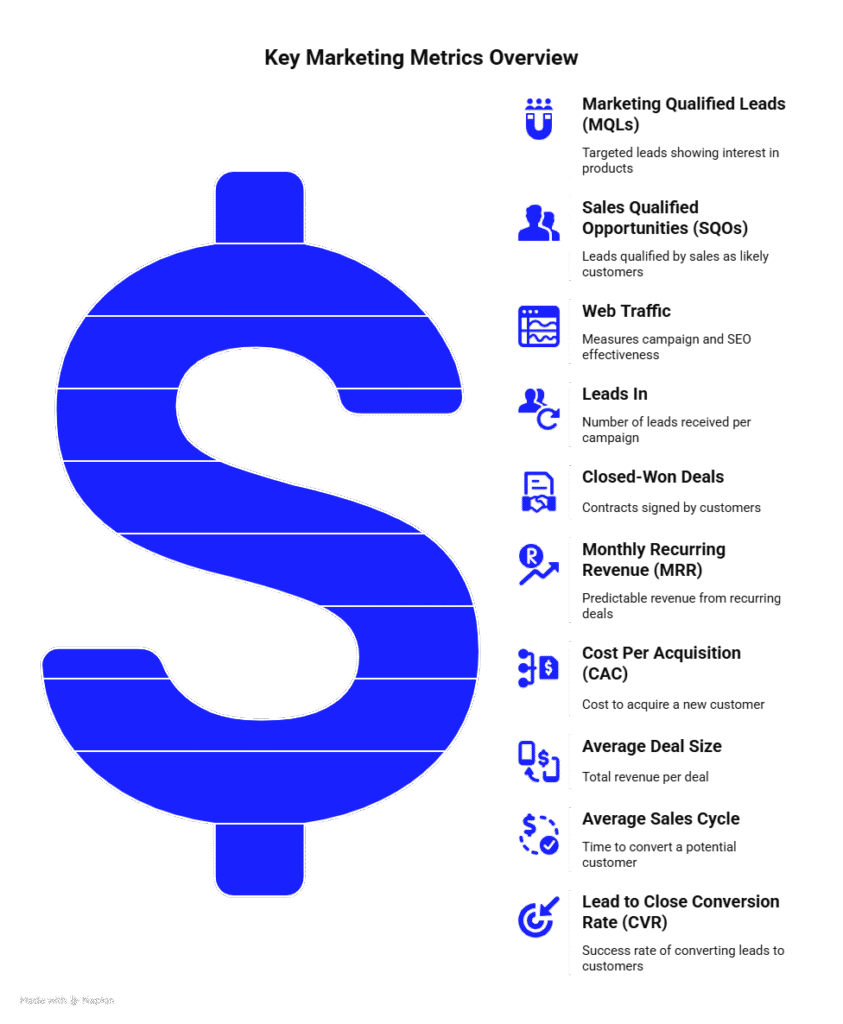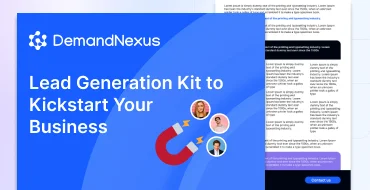Data is the backbone of modern B2B marketing. In 2025, businesses aiming to stay competitive must focus on tracking the right B2B marketing metrics to optimize strategies, boost ROI, and align marketing efforts with revenue goals. Whether you’re refining your
SaaS marketing funnel or measuring the success of
B2B digital marketing campaigns, understanding key performance indicators (KPIs) and metrics is critical. This guide dives deep into the essential metrics, why they matter, and how to track them effectively to drive growth.
What Are B2B Marketing Metrics?
B2B marketing metrics are quantifiable data points that measure the performance of your marketing activities. These metrics help you evaluate how well your campaigns attract leads, engage prospects, and convert them into customers. From tracking website traffic to analyzing customer acquisition costs, metrics provide actionable insights to refine your
B2B marketing funnel and achieve business objectives.
Unlike B2C, where impulse purchases are common, B2B marketing often involves longer sales cycles and multiple decision-makers. This makes metrics like sales-qualified leads (SQLs) and pipeline velocity crucial for understanding the health of your
sales funnel.
Why Track B2B Marketing Metrics?
Tracking B2B marketing metrics empowers data-driven decision-making. Here’s why they’re essential:
- Measure Success: Metrics like conversion rates and monthly recurring revenue (MRR) show what’s working and what needs improvement.
- Optimize Budgets: By analyzing cost per lead (CPL) and customer acquisition cost (CAC), you can allocate resources to high-performing channels.
- Align Teams: Metrics bridge the gap between marketing and sales, ensuring both teams focus on shared goals like generating sales-qualified opportunities (SQOs).
- Stay Competitive: Benchmarking against industry standards helps you stay ahead of competitors in the fast-evolving SaaS and B2B landscape.
- Prove ROI: Metrics provide concrete evidence of marketing’s impact, making it easier to justify budgets to stakeholders.
KPIs vs. Metrics: What’s the Difference?
While the terms are often used interchangeably, KPIs and metrics serve distinct purposes:
| Aspect |
Metrics |
KPIs |
| Definition |
Data points that track performance (e.g., website traffic, click-through rate). |
Strategic goals tied to business objectives (e.g., increase MRR by 20%). |
| Purpose |
Measure progress and campaign health. |
Guide decision-making and set future targets. |
| Example |
Cost per click (CPC), social media engagement. |
Reduce churn rate by 15%, increase SQLs by 10%. |
Metrics are the building blocks that inform KPIs. For example, if your KPI is to boost lead-to-customer conversion rates, you’d track metrics like demo-to-close rate and cost per lead to measure progress.
Top 15 B2B Marketing Metrics to Track in 2025
Here are the must-track metrics for
B2B SaaS companies and other B2B businesses, organized by category:
Lead Generation Metrics
- Marketing Qualified Leads (MQLs): Leads showing interest through actions like downloading a whitepaper or attending a webinar. MQLs indicate the quality of your lead nurturing strategy.
- Sales Qualified Leads (SQLs): Leads vetted by sales as ready for direct engagement. Tracking SQLs ensures marketing delivers high-potential prospects.
- Cost per Lead (CPL): Calculated as total marketing spend divided by the number of leads generated. Lower CPLs signal efficient campaigns.
Engagement Metrics
- Website Traffic: Measures the volume and sources of visitors to your site. Use tools like Google Analytics to track organic, paid, and referral traffic.
- Social Media Engagement: Includes likes, shares, and comments. High engagement reflects strong B2B content marketing.
- Click-Through Rate (CTR): The percentage of users clicking on a link or ad. A high CTR indicates compelling messaging.
Conversion Metrics
- Conversion Rate: The percentage of leads or visitors completing a desired action, like signing up for a demo. Track this at each funnel stage.
- Lead-to-Customer Conversion Rate: Measures how many leads become paying customers. A low rate may signal issues in the sales funnel.
- Customer Acquisition Cost (CAC): Total cost of acquiring a new customer. Keep CAC low to maintain profitability.
Revenue Metrics
- Monthly Recurring Revenue (MRR): Predictable revenue from subscriptions. Break it down into New MRR and Expansion MRR for deeper insights.
- Customer Lifetime Value (CLV): Total revenue expected from a customer over their relationship with your business. Higher CLV drives long-term growth.
- Average Revenue Per User (ARPU): Average revenue generated per customer. Use ARPU to assess pricing and upselling strategies.
Retention and Satisfaction Metrics
- Churn Rate: The percentage of customers who stop using your service. Reducing churn is critical for SaaS companies.
- Customer Satisfaction Score (CSAT): Measures customer happiness. High CSAT correlates with lower churn and higher retention.
- Onboarding Completion Rate: The percentage of new customers completing onboarding. A high rate reduces early churn.
Account-Based Marketing (ABM) Metrics
For businesses using
account-based marketing, these metrics are vital:
- Coverage: Tracks whether you’re reaching key stakeholders in target accounts.
- Engagement: Measures the depth of interactions, like website visits or webinar attendance.
- Pipeline Velocity: How quickly accounts move through the sales pipeline. Faster velocity indicates an efficient funnel.
- Account Win Rate: The percentage of target accounts that become customers.

Case Study: How DemandNexus Boosted Metrics for a SaaS Client
Client: A mid-sized SaaS company offering project management software.
Challenge: The client struggled with low MQL-to-SQL conversion rates and high CAC, making it hard to scale efficiently.
Solution: DemandNexus implemented a data-driven
SaaS go-to-market strategy, focusing on targeted content marketing and optimized lead nurturing. We used advanced analytics to identify high-potential leads and streamlined their sales funnel.
Results:
- Increased MQL-to-SQL conversion rate by 25% within three months.
- Reduced CAC by 15% through better channel allocation.
- Boosted MRR by 18% with improved lead quality and faster pipeline velocity.
DemandNexus’s tailored approach shows how precise metrics tracking can transform B2B marketing outcomes. Ready to optimize your metrics? Contact DemandNexus to build a strategy that drives measurable results.
How to Choose the Right KPIs
Selecting KPIs that align with your business goals is critical. Follow these steps:
- Align with Objectives: If revenue growth is the goal, prioritize KPIs like MRR or CLV.
- Use SMART Criteria: Ensure KPIs are Specific, Measurable, Achievable, Relevant, and Time-bound.
- Balance Indicators: Combine leading (e.g., website traffic) and lagging (e.g., MRR) indicators for a complete picture.
- Review Regularly: Adjust KPIs as business priorities or market conditions change.
Creating a Metrics Tracking Template
A well-structured template simplifies metrics tracking. Here’s how to build one:
| Metric |
Current Value |
Target Value |
Data Source |
Action Steps |
Owner |
| MQLs |
150/month |
200/month |
CRM |
Optimize landing pages |
Marketing Lead |
| CAC |
$500 |
$400 |
Ad Platform |
Shift budget to high-ROI channels |
CMO |
| MRR |
$50,000 |
$60,000 |
Billing System |
Upsell existing customers |
Sales Lead |
Pro Tips:
- Use tools like Google Data Studio or HubSpot for automated dashboards.
- Include visual indicators (e.g., green for on-target, red for off-target).
- Compare with past performance to spot trends.
- Assign owners and deadlines for accountability.
B2B vs. B2C Metrics: Key Differences
While some metrics overlap, B2B and B2C marketing differ significantly:
| Aspect |
B2B |
B2C |
| Sales Cycle |
Longer, involving multiple stakeholders. |
Shorter, often impulse-driven. |
| Key Metrics |
MQLs, SQLs, pipeline velocity. |
Cart abandonment, repeat purchases. |
| Focus |
Relationship-building, account-based strategies. |
Brand awareness, quick conversions. |

Tools for Tracking B2B Marketing Metrics
Leverage these tools to streamline metrics tracking:
- Google Analytics: For website traffic and user behavior.
- HubSpot: For CRM, lead tracking, and funnel analytics.
- LinkedIn Ads: For social media engagement and paid campaign metrics.
- Ahrefs: For SEO and organic traffic insights.
- Tableau: For advanced data visualization and dashboards.
Final Thoughts
In 2025, mastering B2B marketing metrics is non-negotiable for driving growth and proving marketing’s value. By tracking metrics like MQLs, CAC, and MRR, and aligning them with strategic KPIs, you can optimize your B2B SaaS marketing funnel, shorten sales cycles, and boost revenue. A structured template and the right tools make it easier to stay data-driven and agile in a competitive landscape.
Need help refining your metrics strategy? DemandNexus specializes in data-driven B2B marketing solutions, from lead generation to funnel optimization. Contact us today to elevate your
B2B lead generation and achieve measurable success.






